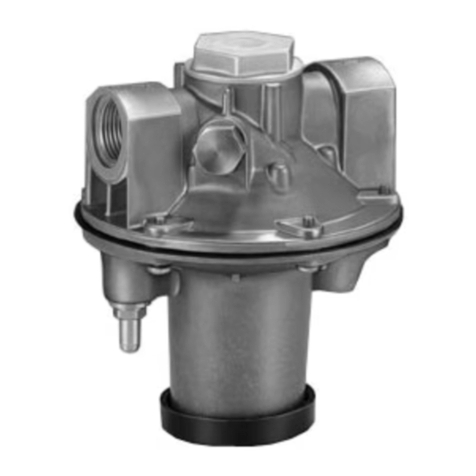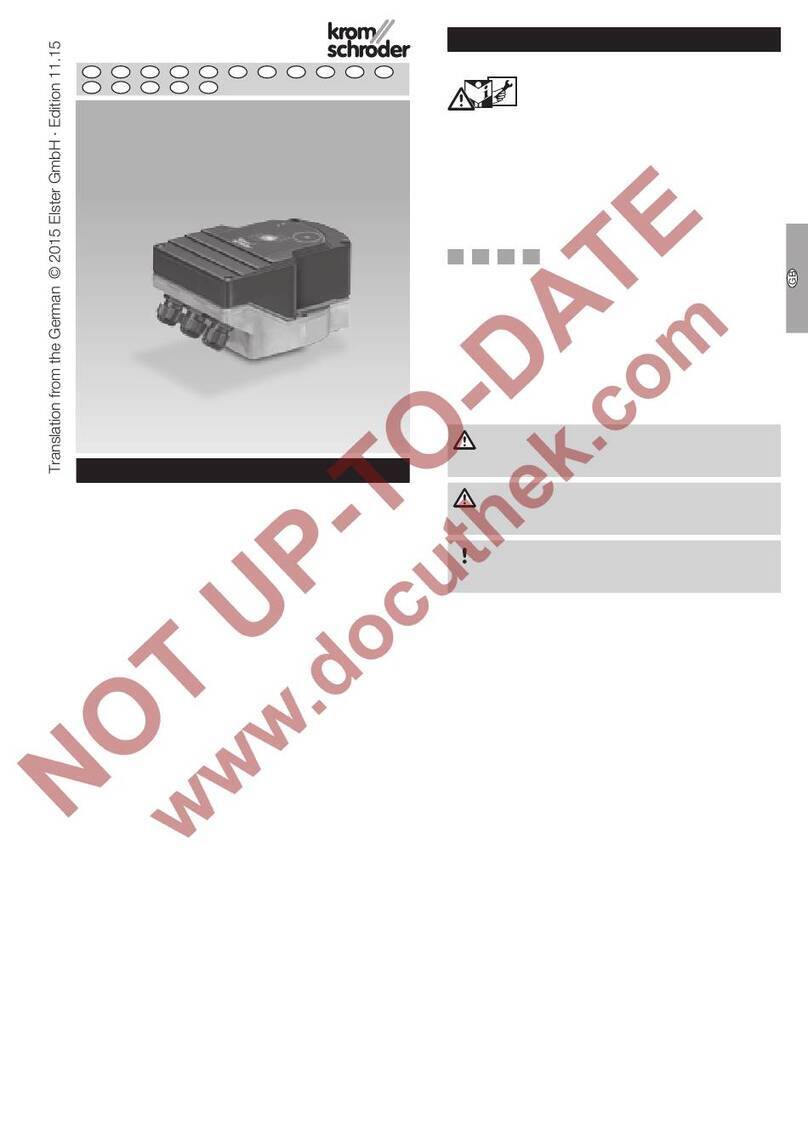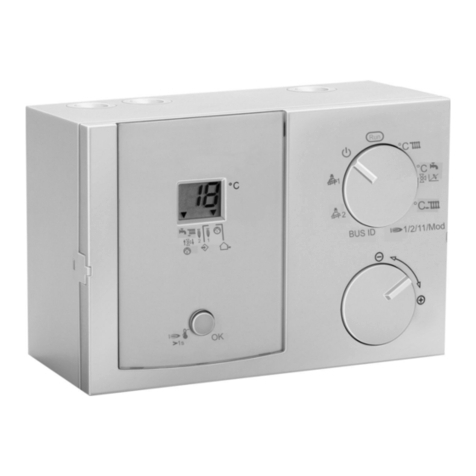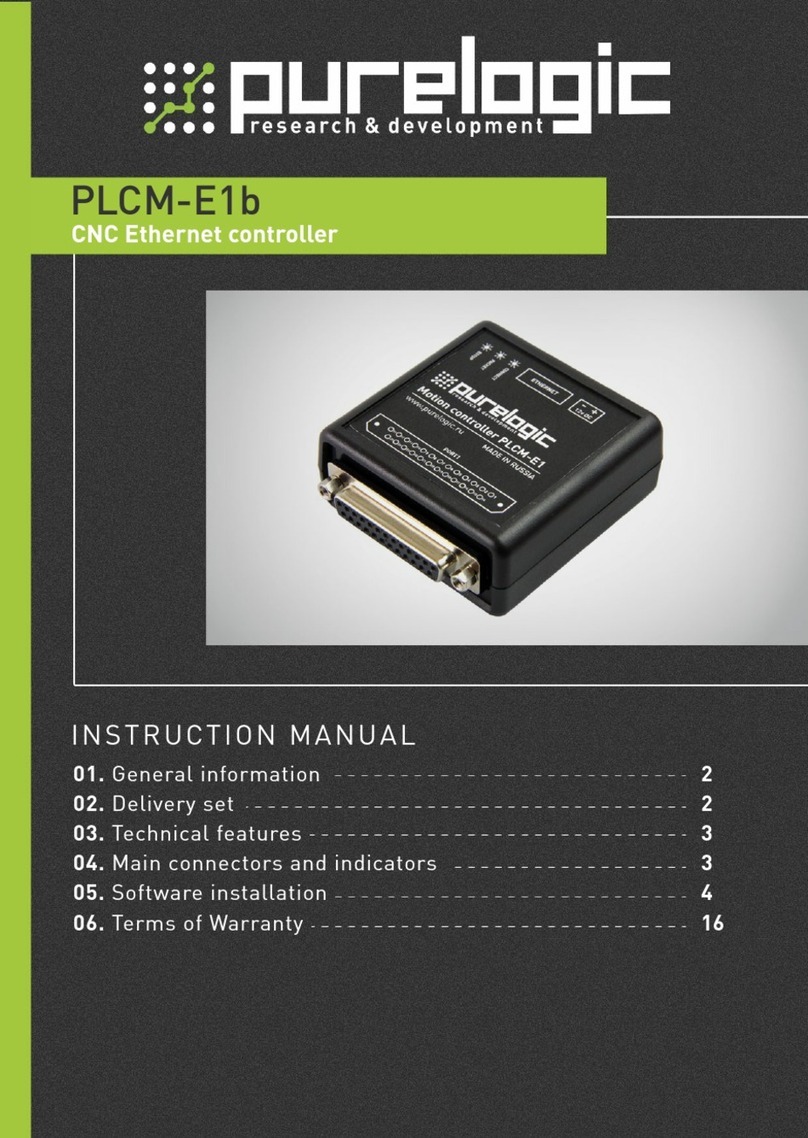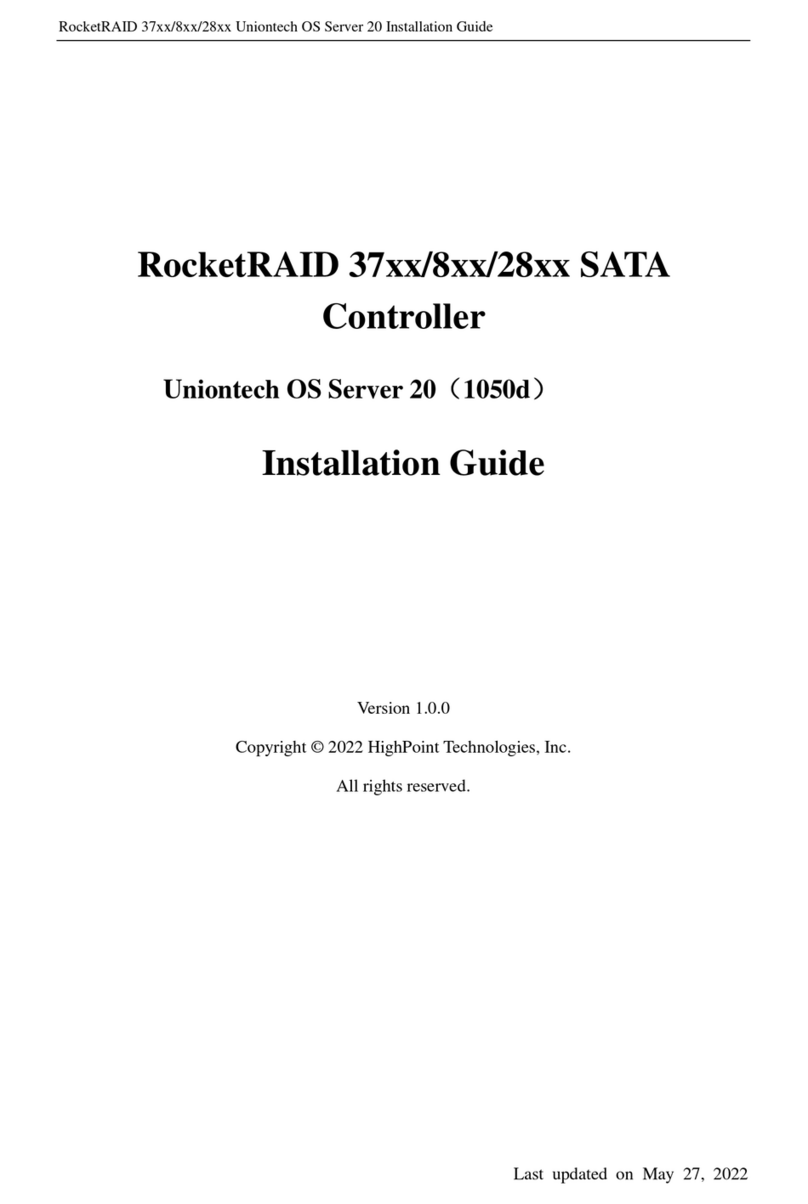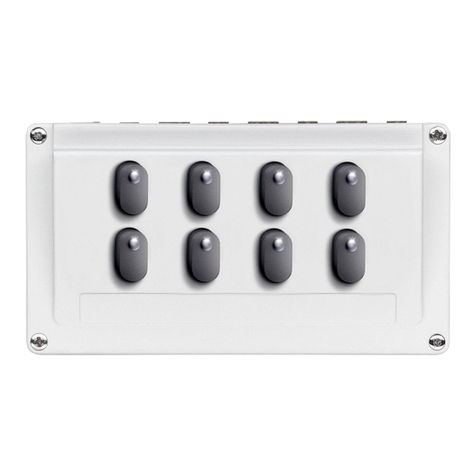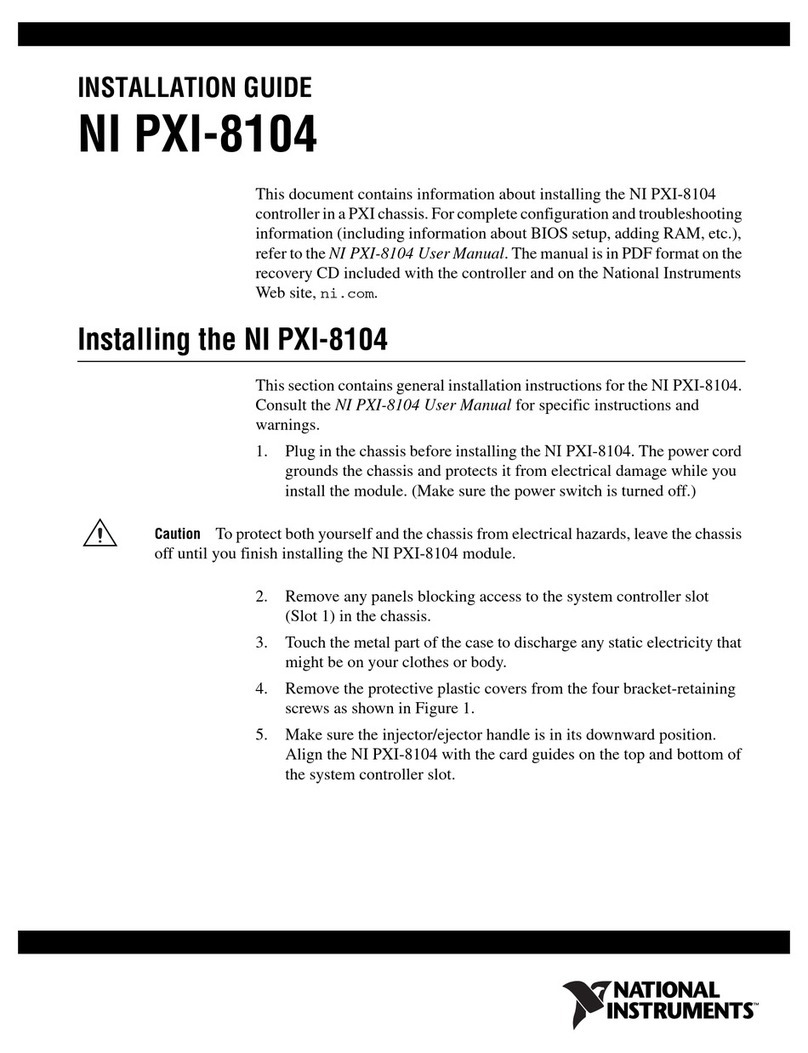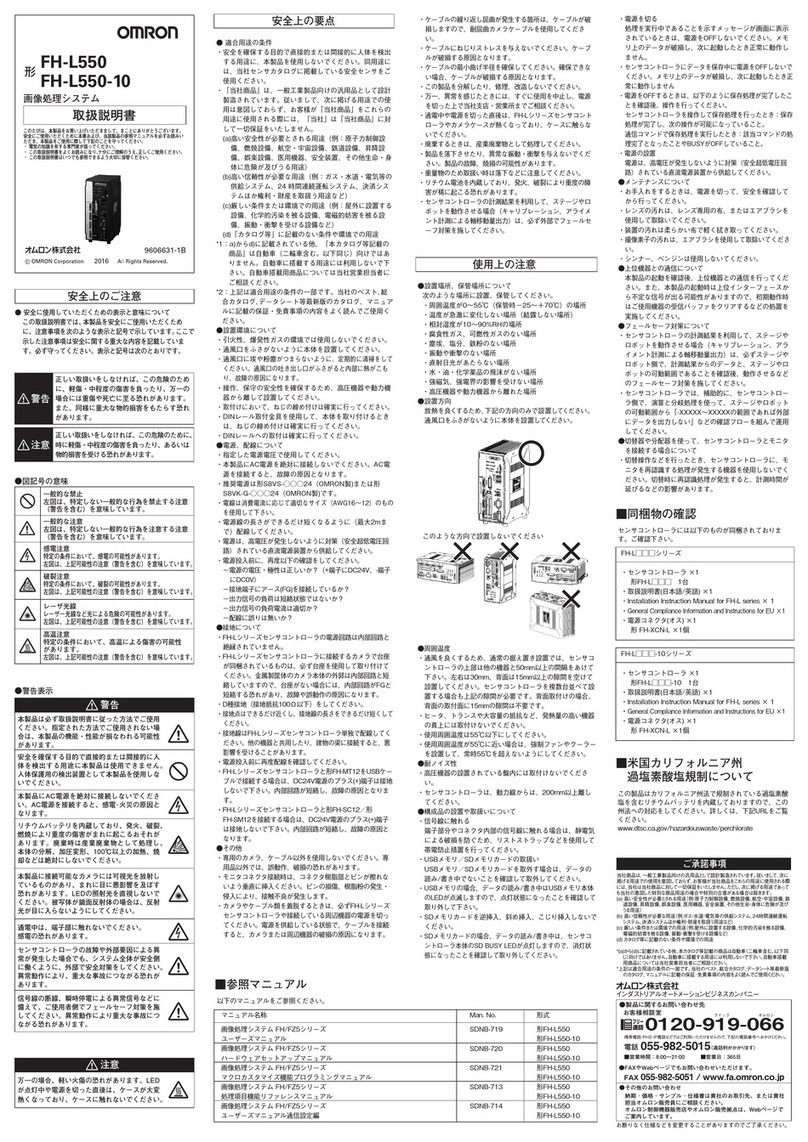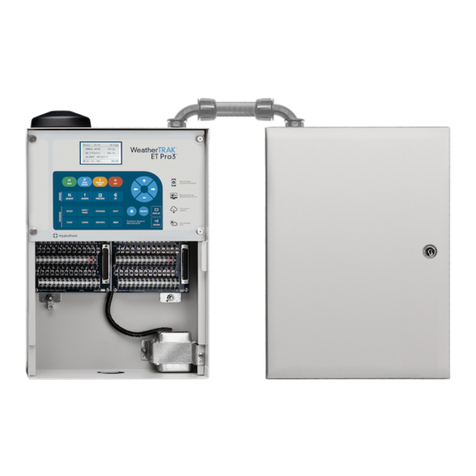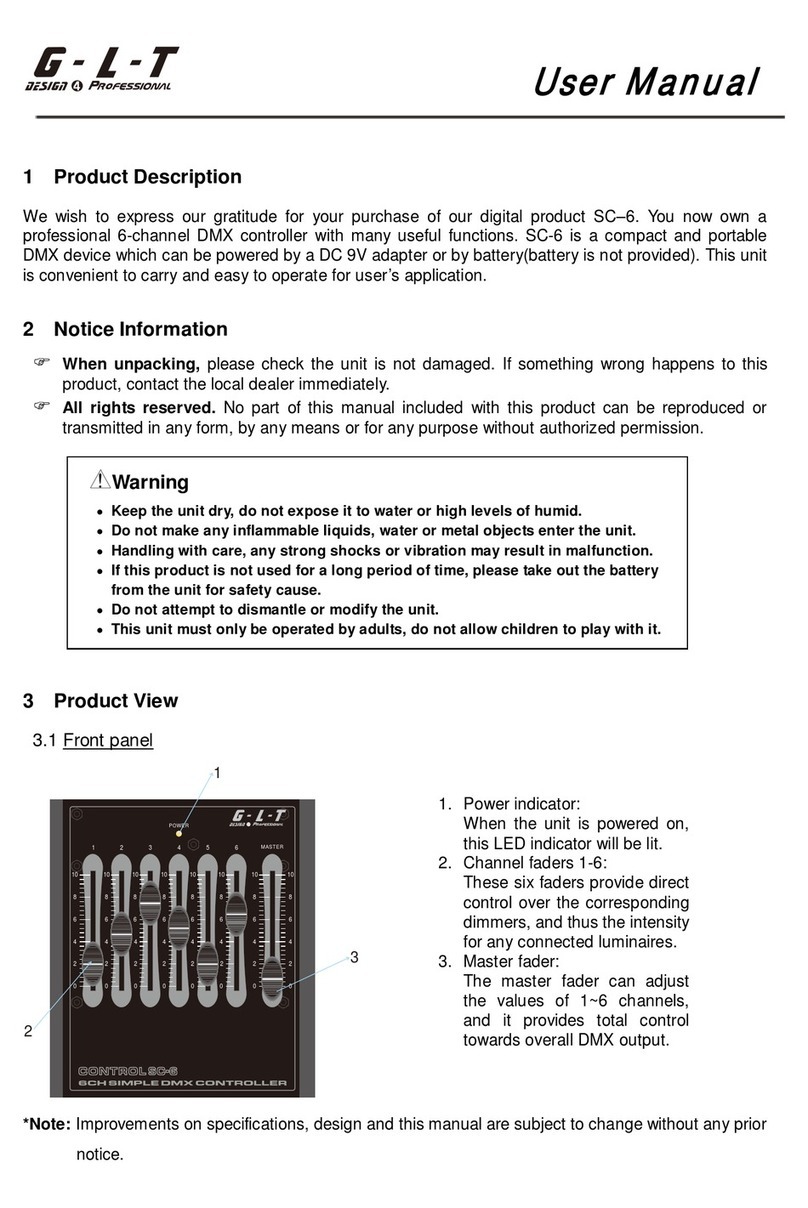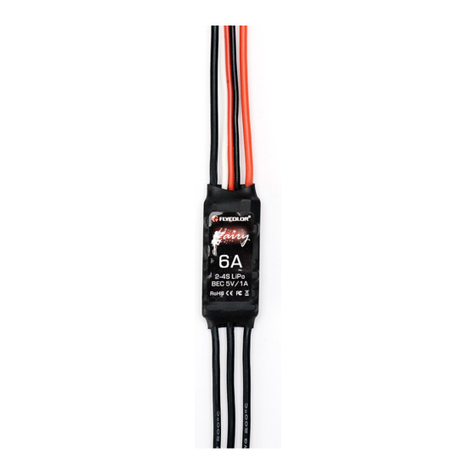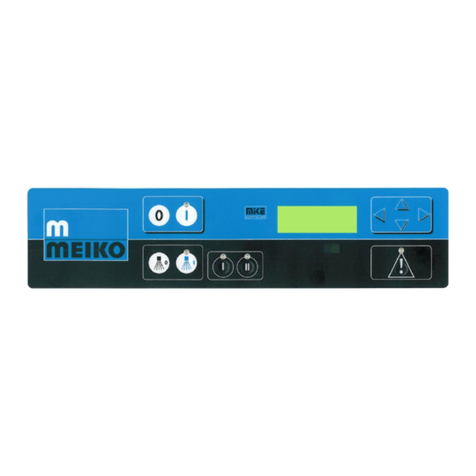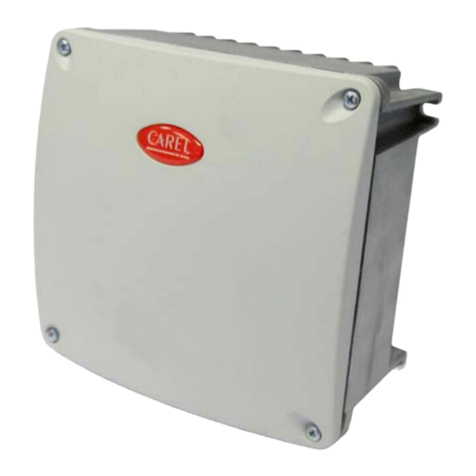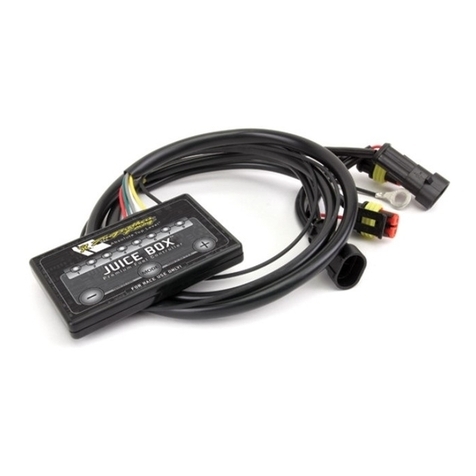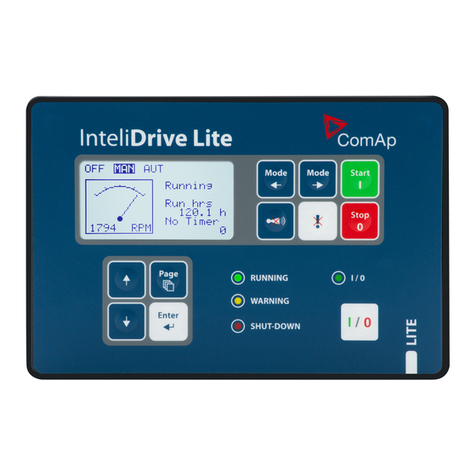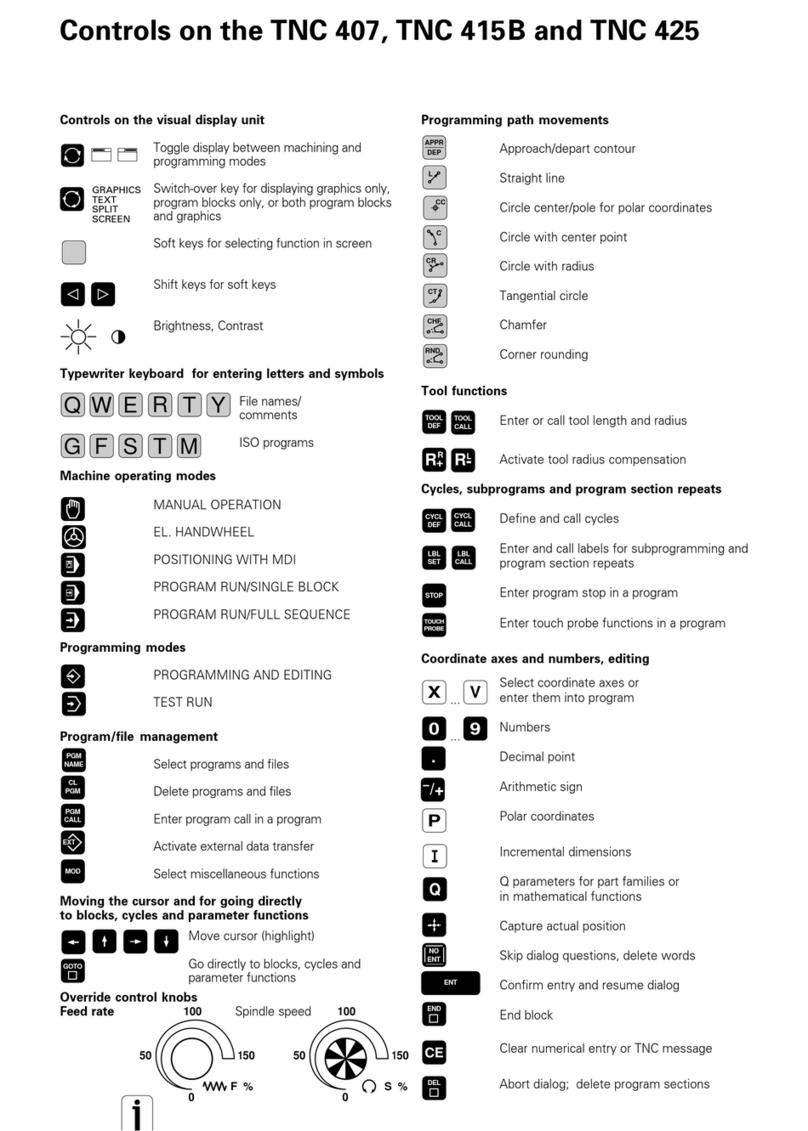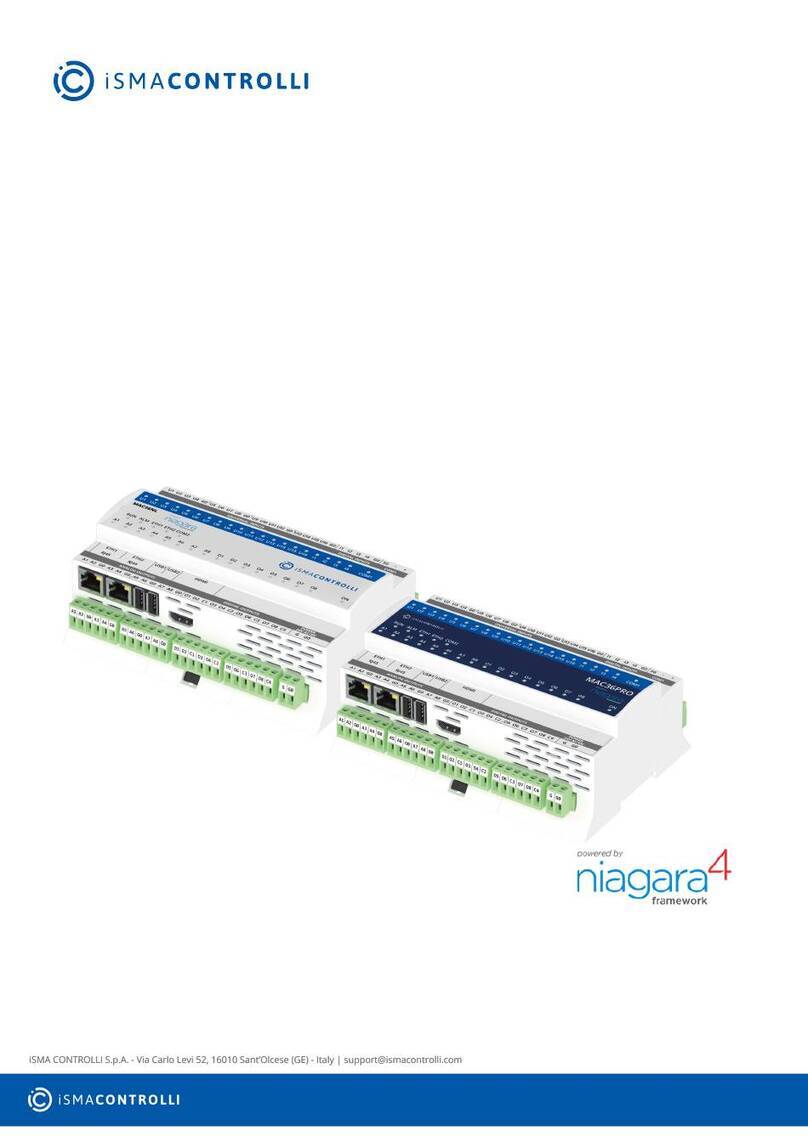Krom Schroder VAD User manual

DK S N P GR
➔www.docuthek.com
D GB F NL I E
TR CZ PL RUS H
Cert. version 03.17
© 2019 Elster GmbH · Edition 01.19
Safety
Please read and keep in a safe place
Please read through these instructions
carefully before installing or operating. Following the
installation, pass the instructions on to the opera-
tor. This unit must be installed and commissioned
in accordance with the regulations and standards
in force. These instructions can also be found at
www.docuthek.com.
Explanation of symbols
• , 1 , , 3 ... = Action
▷= Instruction
Liability
We will not be held liable for damage resulting from
non-observance of the instructions and non-com-
pliant use.
Safety instructions
Information that is relevant for safety is indicated in
the instructions as follows:
DANGER
Indicates potentially fatal situations.
WARNING
Indicates possible danger to life and limb.
CAUTION
Indicates possible material damage.
All interventions may only be carried out by qualified
gas technicians. Electrical interventions may only be
carried out by qualified electricians.
Conversion, spare parts
All technical changes are prohibited. Only use OEM
spare parts.
Changes to edition 0.18
The following chapters have been changed:
– Installation
– Technical data
– Logistics
– Certification
Contents
Operating instructions
D
GB
F
NL
I
E
GB-1
0350481
Translation from the German
Pressure regulators with solenoid
valve VAD, VAG, VAV, VAH
Flow rate regulator VRH
Pressure regulators with
double solenoid valve
VCD, VCG, VCV,VCH
Pressure regulators with solenoid valve
VAD, VAG, VAV, VAH ....................1
Flow rate regulator VRH .................1
Pressure regulators with double solenoid
valve VCD, VCG, VCV,VCH ...............1
Checking the usage .....................
Installation ............................3
Installing the gas/air control lines .........5
Wiring ................................6
Tightness test ..........................8
Commissioning.........................9
Replacing the actuator .................11
Maintenance ..........................11
Accessories ..........................11
Pressure switch for gas DG..VC............11
Bypass/pilot gas valves ..................12
Checking the bypass/pilot gas valve for
tightness .............................13
Cable gland set for double solenoid valves....14
Attachment block.......................15
Seal set for sizes 1–3 ...................15
Cable gland with pressure equalization element15
Technical data ........................16
Logistics .............................18
Certification ..........................18
Contact ..............................0

GB-2
D
GB
F
NL
I
E
Checking the usage
Intended use
Pressure regulators with solenoid valve VAD,
VAG, VAV, VAH
Type Designation of regulator type
VAD Pressure regulator with solenoid valve
VAG Air/gas ratio control with solenoid valve
VAV Variable air/gas ratio control with solenoid
valve
VAH Flow rate regulator with solenoid valve
Constant pressure governor VAD for shut-off and pre-
cise control of the gas supply to excess air burners,
atmospheric burners or force draught gas burners.
Air/gas ratio control VAG for shut-off and for main-
taining a constant air/gas pressure ratio of 1:1 for
modulating-controlled burners or with bypass valve
for stage-controlled burners. Can be used as zero
governor for gas engines.
Variable air/gas ratio control VAV for shut-off and
for maintaining a constant air/gas pressure ratio for
modulating-controlled burners. The transmission
ratio of gas to air can be set from 0.6:1 to 3:1. Pres-
sure fluctuations in the combustion chamber can be
compensated via the combustion chamber control
pressurepsc.
Flow rate regulator VAH for maintaining a constant
gas/air ratio for modulating-controlled and stage-
controlled burners. The gas flow rate is controlled
proportionally to the air flow rate. In addition, the flow
rate regulator with gas solenoid valve shuts off the
gas or air supply safely.
Flow rate regulator VRH
Type Designation of regulator type
VRH Flow rate regulator
Flow rate regulator VRH for maintaining a constant
gas/air ratio for modulating-controlled and stage-
controlled burners. The gas flow rate is controlled
proportionally to the air flow rate.
Pressure regulators with double solenoid
valve VCD, VCG, VCV,VCH
Type Combination of
gas solenoid valve +
regulator with solenoid valve
VCD VAS + VAD
VCG
VAS + VAG
VCV VAS + VAV
VCH VAS + VAH
Gas solenoid valves VAS for safeguarding gas or
air on various appliances. Pressure regulators with
double solenoid valveVCx are combinations of two
gas solenoid valves with a pressure regulator.
This function is only guaranteed when used within the
specified limits– see page16 (Technical data). Any
other use is considered as non-compliant.
Type code
Code Description
VAD
VAG
VAV
VAH
VRH
Pressure regulator with solenoid valve
Air/gas ratio control with solenoid valve
Variable air/gas ratio control with solenoid
valve
Flow rate regulator with solenoid valve
Flow rate regulator
1 – 3 Size
TT-product
15 – 50
Nominal inlet and outlet diameter
R
N
F
Rp internal thread
NPT internal thread
ISO flange
/N1) Quick opening, quick closing
K1)
P1)
Q1)
Y1)
W1)
Mains voltage: 24VDC
Mains voltage: 100VAC; 50/60 Hz
Mains voltage: 120 VAC; 50/60 Hz
Mains voltage: 200 VAC; 50/60 Hz
Mains voltage: 230 VAC; 50/60 Hz
S1)
G1) Closed position indicator
Closed position indicator for 24V
R1)
L1)
Viewing side (in flow direction):
from the right
Viewing side (in flow direction):
from the left
-5
-50
-100
Outlet pressure pdfor VAD:
2.5–25 mbar
20–50 mbar
35–100 mbar
A
B
Standard valve seat
Reduced valve seat
E
K
A
N
Connection kit for air control pressurepsa:
VAG, VAV, VAH, VRH: compression fitting
VAG, VAV: plastic hose coupling
VAG, VAV, VAH, VRH: NPT 1/8adapter
VAG: zero governor
1) Only available for VAD, VAG, VAV, VAH
Part designations
VAx..S,
VAx..G
VAD, VAG,
VAV, VAH
VRH
1
2
3
4
8
6
7
5

GB-3
D
GB
F
NL
I
E
1Solenoid actuator
Flow body
3Connection box
4Connection flange
5Closed position indicator CPI
6Connection parts
7Sealing plug
8Regulator
Mains voltage, electrical power consumption, ambi-
ent temperature, enclosure, inlet pressure and instal-
lation position: see type label.
www.kromschroeder.com
Osnabrück, Germany
VAx ...
.XXXX
Installation
CAUTION
Please observe the following to ensure that the unit
is not damaged during installation and operation:
– Dropping the device can cause permanent dam-
age. In this event, replace the entire device and
associated modules before use.
– Important! The gas must be dry in all conditions
and must not contain condensate.
– Sealing material and dirt, e.g. thread cuttings,
must not be allowed to get into the valve hous-
ing. Install a filter upstream of every system.
– Always install an activated carbon filter upstream
of the regulator when air is the medium. Other-
wise, the ageing of elastomer materials will be
accelerated.
– It is not permitted to install gas solenoid
valveVAS downstream of flow rate regula-
torVAH/VRH and upstream of fine-adjusting
valveVMV. The VAS would no longer be able
to perform its function as a second safety valve
if installed in the above-mentioned position.
– Do not store or install the unit in the open air.
– If more than three valVario controls are installed
in line, the controls must be supported.
– Do not clamp the unit in a vice. Only secure the
flange by holding the octagon with a suitable
spanner. Risk of external leakage.
– Devices with POC/CPI VAx..SR/SL: actuator
cannot be rotated.
– In the case of double solenoid valves, the posi-
tion of the connection box can only be changed
by removing the actuator and reinstalling it ro-
tated by 90° or180°.
–
Cleaning work on the solenoid actuator may not be
performed using high pressure and/or chemical clean-
ing agents. This can cause moisture to get into the
solenoid actuator and may lead to a dangerous failure.
– Note the inlet and outlet pressures, see
page16 (Technical data).
▷
When using a non-return gas valveGRS, we
recommend installing the non-return gas valve
upstream of the regulator and downstream of
the gas solenoid valves due to the permanent
pressure loss on theGRS.
▷
When joining two valves, determine the posi-
tion of the connection boxes, push through the
knock-outs in the connection boxes and install a
cable gland set before installation in the pipework.
Order No. for cable gland set:
Size 1: 74921985, size 2: 74921986, size 3:
74921987.
▷
Install the unit in the pipe free of mechanical
stress.
▷
For retrofitting a second gas solenoid valve, use
the double block seal instead of O-rings. The
double block seal is supplied with the seal set.
Order No. for seal set:
Size 1: 74921988, size 2: 74921989, size 3:
74921990.
▷Installation position:
VAD, VAG, VAH: black solenoid actuator in the
vertical upright position or tilted up to the hori-
zontal, not upside down.
VAG/VAH/VRH in the horizontal position with
modulating control: min. inlet pressure pumin. =
80 mbar (32 "WC).
VAV: black solenoid actuator in the vertical posi-
tion, not upside down.
V
AD, VAG,
V
AH, VRH
VAD, VAG,
VAV, VAH,
VRH
▷
The housing must not be in contact with masonry.
Minimum clearance 20mm (0.78").
▷
To prevent vibrations, keep the volume between
the regulator and burner small by using short
pipes (≤0.5m, ≤19.7").
▷
The inlet pressurepucan be measured using
pressure test points on the flow body on both
sides.
pu
pd
▷
The outlet pressure p
d
(p
d
and p
d-
) and the air
control pressure psa (psa and psa-) must only
be measured at the designated places on the
regulator using pressure test points.

GB-4
D
GB
F
NL
I
E
VAD
p
u
pd
(psa)
▷A combustion chamber control line (psc) can be
connected at connection p
sa
to keep the burner
capacity constant (1/8" coupling with compres-
sion fitting for 6 x 1 tube).
VAG
pupu
pd
pd
pu
psa
pd
pu
pd-
pd
psa-
psa
VAV
pupu
pd
pd
pu
psa
pd
pu
pd-
pd
psa-
psa
VAH, VRH
pupu
pd
pd
pu
psa
pd
pu
pd-
pd
psa-
psa
▷
To increase the control accuracy, an external
impulse line can be connected, instead of the
pressure test pointpd:
Gas impulse line pd: distance from flange
≥3xDN, use a steel tube 8x1mm and a
G1/8.. coupling for D= 8mm.
CAUTION
Do not bridge downstream VAS with external
impulse line.
Strainer
▷A strainer must be fitted in the unit on the inlet
side. If two or more gas solenoid valves are in-
stalled in line, then a strainer only needs to be
fitted on the inlet side of the first valve.
Differential pressure orifice
▷
An appropriate differential pressure orifice with
rubber seals(G) must be inserted at the outlet
of the unit, depending on the pipe.
Gd
Size Pipe Differential pressure orifice
Colour/
Outlet diameter
Ø
1DN 15 yellow/Ø 18,5 mm
1DN 20 green/Ø 25 mm
1DN 25 transparent/Ø 30 mm
2DN 40 transparent/Ø 46 mm
3DN 50 transparent/Ø 58 mm
▷
If pressure regulator VAD/VAG/VAV1 is retrofitted
upstream of gas solenoid valve VAS1, a DN25
differential pressure orifice with outlet opening
d=30mm(1.18") must be inserted at the outlet
of the pressure regulator.
In the case of pressure regulator VAx115 or
VAx120, the DN25 differential pressure orifice
must be ordered separately and retrofitted, Order
No.74922240.
▷The retaining frame must be fitted to secure the
differential pressure orifice at the outlet of the
regulator.
Retaining frame
▷If two controls (regulators or valves) are assem-
bled, a retaining frame with double block seal
must be fitted.
Order No. for seal set:
Size 1: 74921988, size 2: 74921989, size 3:
74921990.
▷
The seals in some gas compression fittings
are approved for temperatures of up to 70°C
(158°F). This temperature limit will not be ex-
ceeded if the flow through the pipe is at least
1m3/h (35.31SCFH) of gas and the maximum
ambient temperature is 50°C (122°F).

GB-5
D
GB
F
NL
I
E
Regulator with flanges
1 Note direction of flow.
2 3
Regulator without flanges
1 Note direction of flow.
2 3 4
5 6 7
▷O-ring and strainer (Fig.4) must be fitted.
2 3 4
5 6 7
Installing the gas/air control lines
CAUTION
Please observe the following to ensure that the unit
is not damaged during operation:
– Fit control lines so that no condensation can
enter the unit.
– The control lines must be as short as possible.
Internal diameter ≥3.9mm(0.15").
– Any bends, restriction points, deviations or air
control valves must be at a distance of at least
5xDN from the connection.
–Pressures, adjusting range, transmission ratio
and pressure differentials, see page16 (Tech-
nical data).
VAG
Installing the air control linepsa
1 Install the connection for the air control line in
the centre of a straight pipeline which is at least
10xDN long.
▷
VAG..K: 1 1/8" coupling for plastic hose (internal
dia. 3.9mm(0.15"), external dia. 6.1mm(0.24"))
or
VAG..E: 1 1/8" coupling with compression fitting
for 6x1tube.
▷VAG..N: connection psa must remain open.
5xDN
5xDN
psa
VAV
Installing the air control linepsa and the
combustion chamber control linepsc
psc
psa
VAS
VAV
DG..C
(DG..VT)
min.
▷
VAV..K: 2 plastic hose couplings (internal dia.
3.9mm(0.15"); external dia. 6.1mm(0.24"))
available.
▷
Do not remove the couplings or replace them
with other types of coupling.
1 Route air control linepsa and combustion cham-
ber control linepsc to the test points for air and
combustion chamber pressure.
▷
If p
sc
is not connected, do not plug the opening!
Install the connection for the air control line in
the centre of a straight pipeline which is at least
10xDN long.

GB-6
D
GB
F
NL
I
E
5xDN
5xDN psc
psa
VAH/VRH
Installing the air control lines psa/psa- and the
gas control linepd-
▷
3 1/8" couplings with compression fitting for
6x1tube.
1 To measure the differential air pressure, install a
measuring orifice in the air line, ensuring that the
inlet and outlet section is ≥5DN.
Connect the air control linepsa to the inlet of the
measuring orifice and the air control linepsa- to
the outlet of the measuring orifice.
▷pdis an internal hole/feedback in the unit.
VAH
VMV
VMO
VAH
psa
pd-
psa-
M
VRH
VMV
VRH
psa psa-
pd-
M
3 We recommend installing a fine-adjusting valve
VMV directly downstream of the regulator in the
gas line. See “Filter module VMF, measuring ori-
fice VMO, fine-adjusting valve VMV” operating
instructions. The instruction manual can also be
found at www.docuthek.com.
2,5 mm
▷
If, instead of installing a VMV, a measuring orifice
is installed in the gas line, ensure that the inlet
and outlet section is ≥5DN.
4 Connect the gas control line pd- to the VMV or
to the measuring orifice.
pd-
5xDN
5xDN
psa-
psa
Wiring
WARNING
Please observe the following to ensure that no
damage occurs:
– Electric shocks can be fatal! Before working
on possible live components, ensure the unit
is disconnected from the power supply.
– The solenoid actuator heats up during opera-
tion. Surface temperature approx. 85°C (approx.
185°F).
VAD, VAG, VAV, VAH
▷Use temperature-resistant cable (>90°C).
1 Disconnect the system from the electrical power
supply.
Shut off the gas supply.
▷Wiring to EN 60204-1.
▷
UL requirements for the NAFTA market. To main-
tain the UL environmental rating Type 2, the en-
closure openings shall be closed with fittings
rated UL Type 2; 3; 3R; 3RX; 3S; 3SX; 3X; 4X;
5; 6; 6P; 12; 12K or 13. Gas solenoid valves
shall be protected by a branch circuit protective
device not exceeding 15A.

GB-7
D
GB
F
NL
I
E
▷
When joining two valves, install a cable gland
set between the connection boxes.
Order No. for cable gland set:
Size 1: 74921985, size 2: 74921986, size 3:
74921987.
43
First push
through the
knock-out –
then unscrew
the cover!
▷If the M20 cable gland or plug is already fitted, it
is not necessary to push through the knock-out.
M0 cable gland
(+)
LV1N
(-)
LV1NLV 1N
(+)(+)(-)(-)
5 6
78 9
Plug
LV1V1 (+) = black, LV1V2 (+) = brown, N (–) = blue
(+)
LV1 N
(-)
LV1 NLV 1 N
(+) (+) (-)(-)
5 6
7 8
When installing two plugs
on a VAx with closed position
indicator: label the sockets and
plugs to avoid confusion.
(+)
LV1 N
(-)
LV1 NLV 1 N
(+) (+) (-)(-)
5 6
7 8
When installing two plugs
on a VAx with closed position
indicator: label the sockets and
plugs to avoid confusion.
Socket
1 = N (–), 2 = LV1V1 (+), 3 = LV1V2 (+)
21
3
21
5 6
7 9
8
Closed position indicator
▷VAx open: contacts1andclosed,
VAx closed: contacts 1and 3closed.
▷Indicator of CPI: red = VAx closed, white = VAx
open.
▷Double solenoid valve: if a plug with socket is fit-
ted, either the POC or the CPI can be connected.

GB-8
D
GB
F
NL
I
E
CAUTION
Please observe the following to ensure smooth
operation:
– The closed position indicator is not suitable for
frequent cycling operation.
– Route valve and closed position indicator cables
separately through M20 cable glands or use
two separate plugs. Otherwise, there is a risk of
interference between valve voltage and closed
position indicator voltage.
▷
To make wiring easier, the connection terminal
for the closed position indicator can be removed.
1 32 LV1
(+) N
(-)
1
2
3
1
2
3
1
2
3
1 3
2LV1
(+) N
(-) 132 LV1
(+) N
(-)
LV1
(+) N
(-)
1 32
LV1
(+)
N
(-)
1 32
LV1
(+) N
(-)
21
3
21
CPI
schwarz
weiß
rot
LV1V1 (+) = black, N (–) = blue
1 32 LV1
(+) N
(-)
1
2
3
1
2
3
1
2
3
1 3
2LV1
(+) N
(-) 132 LV1
(+) N
(-)
LV1
(+) N
(-)
1 32
LV1
(+) N
(-)
1 32
LV1
(+) N
(-)
21
3
21
black
white
red
CPI
▷Label the plugs to avoid confusion.
1 = N (–), 2 = LV1V1 (+)
1 32 LV1
(+) N
(-)
1
2
3
1
2
3
1
2
3
1 3
2LV1
(+) N
(-) 132 LV1
(+) N
(-)
LV1
(+) N
(-)
1 32
LV1
(+) N
(-)
1 32
LV1
(+) N
(-)
21
3
21
black
white
red
CPI
▷Ensure that the connection terminal for the CPI
has been reconnected.
Finishing the wiring
Tightness test
1 Close the gas solenoid valve.
To be able to check the tightness, shut off the
downstream pipeline close to the regulator.
▷
On the VAH/VRH, the control line p
d-
leads to
gas-filled space in the regulator. It must be con-
nected before the tightness test.
N
2
0
0
N
2
3
6
4
78
5
0
≤ 1,5 × pu max
≤ 1,5 × pu max
Open the
pressure
regulator.
9 Tightness OK: open the pipeline.
▷Pipeline leaking: replace O-ring on flange.
Order No. for seal set:
Size 1: 74921988, size 2: 74921989, size 3:
74921990.
Then check for tightness once again.
▷Unit leaking: remove the pressure regulator and
return it to the manufacturer.

GB-9
D
GB
F
NL
I
E
Commissioning
▷
During the measurement process, ensure that
the length of the tube is as short as possible for
the determining of the pressures.
VAD
Setting the outlet pressure pd
▷
The outlet pressure is set to p
d
= 10mbar at
the factory.
pd
[mbar] ["WC]
VAD..-25 2.5–25 1–10
VAD..-50 20–50 8–19.7
VAD..-100 35–100 14–40
1 Switch on the burner.
▷Breathing orificeAmust remain open.
Set the regulator to the required outlet pressure.
+
_
0
pd
2,5 mm
A
3 Close off the test point again once the pressure
has been set.
VAG
pd= outlet pressure
psa = air control pressure
▷Factory setting: pd= psa - 1.5 mbar (0.6"WC);
actuator pointing upwards and an inlet pressure
of 20mbar(7.8"WC).
1 Switch on the burner.
Setting the low-fire rate
▷In applications with excess air, the values for pd
and psa may be below the limit, see Technical
data, page 16 (VAG). No situation which would
jeopardize safety must arise. Avoid CO formation.
Set the regulator to the required outlet pressure.
+
_
2,5 mm 0
0pd
psa
3 Close off the test point again once the pressure
has been set.
Setting the high-fire rate
▷Set the high-fire rate using restricting orifices or
adjustment elements on the burner.
VAV
pd= outlet pressure
psa = air control pressure
psc = combustion chamber control pressure
Setting the low-fire rate
▷
If the burner operates at low-fire rate, the gas/air
mixture can be changed by adjusting the adjust-
ing screw“N”.
-1
0+0,5-0,5
–
+1
-1,5
mbar
+1,5
0,6
11,5
2
3
NV
+
+
–
+3
0-1,5+1,5
–
-3
+5
mbar
-5
N
+
VAG, VAH VAV
+
_
,5 mm
+
_
,5 mm
CAUTION
psa - psc ≥ 0.4 mbar (≥ 0.15 "WC).
Controller acting time for the reference variable
(air butterfly valve):
min. to max. > 5 s, max. to min. > 5 s.
▷
Factory setting for transmission ratio of gas to air:
V=1:1, zero pointN=0.
Pre-setting
1 Set zero pointNand transmission ratioVto
scale in accordance with burner manufacturer’s
specifications.
Measure gas pressurepd.
0
0
p
d
p
sa
psc
0
3 Start the burner at low-fire rate. If the burner
does not start, turn Nslightly in direction+ and
repeat start.
4 Gradually increase the burner to high fire and, if
necessary, adjust the gas pressure atV.
5 Set the minimum and maximum capacity on
the air control valve in accordance with burner
manufacturer’s specifications.

GB-10
D
GB
F
NL
I
E
Final adjustment
6 Set the burner to low fire.
7 Conduct a flue gas analysis and set the gas pres-
sure atNto the desired analysis value.
8 Set the burner to high fire and set the gas pres-
sure atVto the desired analysis value.
9 Repeat the analysis at low and high fire and cor-
rect NandVif necessary.
10 Close off all test points. Do not close off connec-
tionpsc if not used!
▷
It is advisable to start the burner at a level higher
than the minimum setting (start gas rate) to en-
sure reliable flame formation.
Calculation
If the combustion chamber control pressurepsc is
not connected:
pd= V × psa + N
Ifcombustionchambercontrolpressurepscisconnected:
(pd- psc) = V × (psa - psc) + N
Testing control capacity
DANGER
Risk of explosion! If the control capacity is insuf-
ficient, the system may not be operated.
11 Set the burner to high fire.
1 Measure the gas pressure at the inlet and outlet.
13 Slowly close the manual valve upstream of the
regulator until the gas inlet pressurepudrops.
▷
The gas outlet pressurepdshould not drop as
well. Otherwise, the setting should be re-checked
and adjusted.
14 Reopen the manual valve.
VAH, VRH
pu= inlet pressure
pd= outlet pressure
Δpd = differential gas pressure (outlet pressure)
psa = air control pressure
Δpsa = differential air pressure (air control pressure)
▷
A gas/air mixture may be applied at the p
sa-
con-
nection for the air control pressure.
▷Inlet pressure pu: max. 500 mbar
▷Air control pressure psa: 0.6 to 100 mbar
▷Differential air pressure Δpsa (psa - psa-)= 0.6to
50mbar
▷Differential gas pressure Δpd(pd- pd-)= 0.6to
50mbar
▷The impulse lines psa, psa- and pd- must be laid
correctly.
VMV
VMO
VAH
psa
pd-
psa-
M
Pre-setting
1 Set the minimum and maximum capacity on
the air control valve in accordance with burner
manufacturer’s specifications.
Switch on the burner.
0
0
pd
psa-
psa pd-
3 Open the fine-adjusting valve VMV slowly, from
the ignitable mixture with excess air to the re-
quired value.
Setting the high-fire rate
4 Slowly increase the burner to high fire and set
the differential gas pressure on the fine-adjusting
valveVMV in accordance with burner manufac-
turer’s specifications.
Setting the low-fire rate
▷
If the burner operates at low-fire rate, the gas/air
mixture can be changed by adjusting the adjust-
ing screwN.
-1
0+0,5-0,5
–
+1
-1,5
mbar
+1,5
0,6
11,5
2
3
NV
+
+
–
+3
0-1,5+1,5
–
-3
+5
mbar
-5
N
+
VAG, VAH VAV
+
_
,5 mm
+
_
,5 mm
▷Factory setting: zero point N = -1.5 mbar
CAUTION
Δpsa = psa - psa- ≥ 0.6 mbar (≥ 0.23 "WC).
Controller acting time for the reference variable
(air butterfly valve): min. to max. > 5 s, max. to
min. > 5 s.
5 Set the burner to low fire.
6 Conduct a flue gas analysis and set the gas pres-
sure atNto the desired analysis value.
7 Set the burner to high fire and set the differential
gas pressure to the desired analysis value.
8 Repeat the analysis at low and high fire and cor-
rect if necessary.
9 Close off all test points.

GB-11
D
GB
F
NL
I
E
Replacing the actuator
See operating instructions enclosed with spare part
or see www.docuthek.com.
Maintenance
CAUTION
In order to ensure smooth operation, check the
tightness and function of the pressure regulator:
– Once per year, twice per year in the case of
biogas; check for internal and external tightness,
see page8 (Tightness test).
– Check electrical installations once a year in line
with local regulations; pay particular attention
to the PEwire, see page6 (Wiring).
▷
If more than one valVario control is installed in
series: the controls may only be removed from
the pipeline and reinstalled on the inlet and outlet
flange all at once.
▷
We recommend replacing the seals, see
page15 (Seal set for sizes 1–3).
▷If the flow rate has dropped, clean the strainer
and the differential pressure orifice.
1 Disconnect the system from the electrical power
supply.
Shut off the gas supply.
3 Detach control line(s).
4 5 6
7
10
89
11
1 Once the seals have been replaced, refit the
strainer and the differential pressure orifice and
install the pressure regulator in the pipeline again.
13 Reattach control line(s) to the regulator.
▷The pressure regulator remains closed.
14 Then check the unit for internal and external
tightness, see page8 (Tightness test).
Accessories
Pressure switch for gas DG..VC
▷
The pressure switch for gas monitors the inlet
pressurepu, the outlet pressurepdand the in-
terspace pressurepz.
DG..C..1
DG..C..9
p
u
pu
pz
pd
▷
When using two pressure switches on the same
side of the double solenoid valve, only the com-
bination DG..C..1 and DG..C..9 may be used for
design reasons.
DG..C..1
DG..C..9
pu
pu
pz
pd
▷
When retrofitting the pressure switch for gas,
see enclosed operating instructions “Pressure
switches for gas DG..C”, section entitled “Mount-
ing the DG..C..1, DG..C..9 on valVario gas so-
lenoid valves”.
▷
The switching point is adjustable via hand wheel.
231
Adjusting range
(adjusting tolerance
= ± 15% of the
scale value)
Mean switching
differential at min.
and max. setting
[mbar] ["WC] [mbar] ["WC]
DG 17VC 2–17 0.8–6.8
0.7–1.7
0.3–0.8
DG 40VC 5–40 2–16 1–2 0.4–1
DG 110VC 30–110 12–44 3–8 0.8–3.2
DG 300VC
100–300
40–120 6–15 2.4–8
▷
Deviation from the switching point during testing
pursuant to EN 1854 Gas pressure switches:
± 15%.

GB-12
D
GB
F
NL
I
E
Bypass/pilot gas valves
1 Disconnect the system from the electrical power
supply.
Shut off the gas supply.
3 Prepare the installed main valve.
▷Turn the actuator so that the side on which the
bypass/pilot gas valve is to be installed is ac-
cessible.
65
4
VBY for VAx 1
Scope of delivery
B
C
A
VBY 8
VAx 1
Rp ¼
(Zündgasventil)
Bypass valve VBY..I
A1 x bypass valve VBY..I
B2 x retaining screws with 4 x O-rings: both retain-
ing screws have a bypass orifice
CGrease for O-rings
▷The screw plug at the outlet remains in place.
Pilot gas valve VBY..R
A1 x pilot gas valve VBY..R
B2 x retaining screws with 5 x O-rings: one retain-
ing screw has a bypass orifice (2x O-rings), the
other does not (3x O-rings)
CGrease for O-rings
▷
Remove the screw plug at the outlet and connect
the Rp¼ pilot gas line.
Mounting the VBY
7 Grease O-rings B.
VBY..I
VBY..R
89
10 11
▷Tighten the retaining screws alternately so that
VBY and the main valve are flush.
Setting the flow rate
▷The flow rate can be set by turning the flow rate
restrictor (4mm hexagon socket) ¼ of a turn.
+
-
▷
Only adjust the flow rate restrictor in the marked
range, otherwise the required gas volume will
not be reached.
1 Wire the socket, see page6 (Wiring).
13 Check for tightness, see page13 (Checking
the bypass/pilot gas valve for tightness).
VAS 1 for VAx 1, VAx , VAx 3
Scope of delivery
A
B
C
VAx 1VAx 2/3
D
F
E
C
A1 x bypass/pilot gas valve VAS1
B4 x O-rings
C4 x double nuts for mounting to VAS1
or
4 x spacer sleeves for mounting to VAS2/3
D4 x connection parts
E1 x mounting aid
Bypass valve VAS 1
F2 x connection pipes, if the bypass valve has a blind
flange on the outlet side.
Pilot gas valve VAS 1
F1 x connection pipe, 1 x sealing plug, if the pilot gas
valve has a threaded flange on the outlet side.

GB-13
D
GB
F
NL
I
E
Mounting the bypass/pilot gas valve VAS1
▷
Always use a connection pipeFat the inlet of
the main valve.
▷
For a bypass valve: use connection pipeF
Ø10mm(0.39") at the outlet of the main valve
if the bypass valve’s outlet flange is designed
as a blind flange.
▷For the pilot gas valve: insert sealing plugFat
the outlet of the main valve if the pilot gas valve’s
outlet flange is designed as a threaded flange.
C
D
E
F
B
B
89
7
13 14
15 16
10 Remove the sealing plugs on the mounting side
of the bypass valve.
VAS 1 to VAx 1
11 Remove the nuts from the connection parts on
the mounting side of the main valve.
1 Remove the connection parts of the bypass/pilot
gas valve.
▷
Use the new connection parts Cand Dfrom the
scope of delivery for the bypass/pilot gas valve.
C
D
E
F
B
B
89
7
13 14
15 16
17 Wire the bypass/pilot gas valve VAS1, see
page6 (Wiring).
18 Check for tightness, see page13 (Checking
the bypass/pilot gas valve for tightness).
VAS 1 for VAx or VAx 3
▷The connection parts of the main valve remain
mounted.
11 Remove the connection parts of the bypass/pilot
gas valve.
▷
Use the new connection parts Cand Dfrom
the scope of delivery for the bypass/pilot gas
valve. For VAx2 and VAx3, the connection parts
consist of self-tapping screws.
C
D
12
13 14
Self-tapping
screws.
15 Wire the bypass/pilot gas valve VAS1, see
page6 (Wiring).
16 Check for tightness, see page13 (Checking
the bypass/pilot gas valve for tightness).
Checking the bypass/pilot gas valve for
tightness
1 To be able to check the tightness, shut off the
downstream pipeline as close as possible to the
valve.
Close the main valve.
3 Close the bypass/pilot gas valve.
CAUTION
If the actuator of the VBY is rotated, the tightness
can no longer be guaranteed. To ensure that there
are no leaks, check the actuator of the VBY for
tightness.
N2≤1,5 x pu max
Check the bypass/pilot gas valve for tightness at
the inlet and outlet.

GB-14
D
GB
F
NL
I
E
N
2
≤
1,5 x p
u max
0
N
2
≤ 1,5 x p
u max
N
2
≤ 1,5 x p
u max
5
4
6
6
Open the
bypass or
pilot gas
valve.
Bypass valve
N
2
≤
1,5 x p
u max
0
N
2
≤ 1,5 x p
u max
N
2
≤ 1,5 x p
u max
5
4
6
6
Bypass- oder
Zündgasventil
öffnen.
Откройте
байпасный
клапан или
газовый кла-
пан запальной
горелки.
Open the
bypass or
pilot gas
valve.
Ouvrir la
vanne de
by-pass ou la
vanne pilote.
Bypass-klep
of aansteek-
gasklep
openen.
Aprire la
valvola di
bypass o la
valvola del
gas pilota.
Abrir la
válvula de
bypass o la
válvula de
gas de
encendido.
Åbn bypass-
eller tænd-
gasventilen.
Abrir a válvula
de bypass ou
de gás piloto.
Ανοίξτε τη
βαλβίδα πα-
ράκαμψης ή
τη βαλβίδα
αερίου ανά-
φλεξης.
Öppna
bypass- eller
tändgas-
ventilen.
Åpne bypass-
eller tenn-
gassventilen.
Otevřít
obtokový
ventil nebo
zapalovací
plynový ventil.
Otworzyć
zawór obej-
ściowy lub
zawór gazu
zapłonowego.
Pilot gas valve
N
2
≤
1,5 x p
u max
0
N
2
≤ 1,5 x p
u max
N
2
≤ 1,5 x p
u max
5
4
6
6
Bypass- oder
Zündgasventil
öffnen.
Откройте
байпасный
клапан или
газовый кла-
пан запальной
горелки.
Open the
bypass or
pilot gas
valve.
Ouvrir la
vanne de
by-pass ou la
vanne pilote.
Bypass-klep
of aansteek-
gasklep
openen.
Aprire la
valvola di
bypass o la
valvola del
gas pilota.
Abrir la
válvula de
bypass o la
válvula de
gas de
encendido.
Åbn bypass-
eller tænd-
gasventilen.
Abrir a válvula
de bypass ou
de gás piloto.
Ανοίξτε τη
βαλβίδα πα-
ράκαμψης ή
τη βαλβίδα
αερίου ανά-
φλεξης.
Öppna
bypass- eller
tändgas-
ventilen.
Åpne bypass-
eller tenn-
gassventilen.
Otevřít
obtokový
ventil nebo
zapalovací
plynový ventil.
Otworzyć
zawór obej-
ściowy lub
zawór gazu
zapłonowego.
Cable gland set for double solenoid valves
▷
When wiring a double solenoid valve, the con-
nection boxes are to be connected using a cable
gland set.
VCx 1 VCx 2 VCx 3
▷Order No. for
size 1: 74921985,
size 2: 74921986,
size 3: 74921987.
▷
We recommend preparing the connection boxes
before the double solenoid valve is installed in the
pipework. Alternatively, one of the actuators must
be dismantled as described below and reinstalled
rotated by 90° in preparation for installation of
the double solenoid valve.
▷The cable gland set can only be used if the con-
nection boxes are at the same height and on
the same side.
1 Disconnect the system from the electrical power
supply.
Shut off the gas supply.
16
54
3
87
6
910
1312
11
1918
17
15
14
Conectar
eléctrica-
mente las
válvulas, ver
el capítulo
“Cableado”.
▷
In both connection boxes, push through the
knock-out for the cable gland set – then remove
the covers. The covers must not be taken off
before pushing through the knock-outs as it pre-
vents damage to the connection boxes.
16
54
3
87
6
910
1312
11
1918
17
15
14
Connect
the valves to
the electrical
power supply,
see section
entitled “Wiring”.

GB-15
D
GB
F
NL
I
E
Attachment block
▷
For locked installation of pressure gauge or other
accessories, the attachment block is mounted
to the solenoid valve.
▷Order No. 74922228
1 Disconnect the system from the electrical power
supply.
Shut off the gas supply.
▷Use the enclosed self-tapping screws for instal-
lation.
N2≤1,5 x pu max
N2≤1,5 x pu max
54
3
7
6
8
11
9 Shut off the downstream gas pipeline close to
the pressure regulator.
10 Open the pressure regulator.
N2≤1,5 x pu max
N2≤1,5 x pu max
54
3
7
6
8
11
Seal set for sizes 1 – 3
▷
When retrofitting accessories or a second valVario
control or when servicing, we recommend
replacing the seals.
C
AB
C
E
D
▷Order No. for
size 1: Order No. 74921988,
size 2: Order No. 74921989,
size 3: Order No. 74921990.
▷Scope of delivery:
A1 x double block seal,
B 1 x retaining frame,
C2 x O-rings (flange),
D2 x O-rings (pressure switch),
for pressure test point/screw plug:
E 2 x sealing rings (flat sealing), 2x profiled
sealing rings.
Cable gland with pressure equalization
element
▷
To avoid the formation of condensation, the cable
gland with pressure equalization element can be
used instead of the standard M20 cable gland.
The diaphragm in the gland is designed to ven-
tilate the device, without allowing water to enter.
▷1 x cable gland, Order No.: 74924686

GB-16
D
GB
F
NL
I
E
Technical data
Ambient conditions
Icing, condensation and dew in and on the unit are
not permitted.
Avoid direct sunlight or radiation from red-hot
surfaces on the unit. Note the maximum medium
and ambient temperatures!
Avoid corrosive influences, e.g. salty ambient air
or SO2.
The unit may only be stored/installed in enclosed
rooms/buildings.
The unit is suitable for a maximum installation
height of 2000 m AMSL.
Ambient temperature:
VAx: -20 to +60°C (-4 to +140°F),
VBY: 0 to +60°C (32 to 140°F).
Long-term use in the upper ambient temperature
range accelerates the ageing of the elastomer ma-
terials and reduces the service life (please contact
manufacturer).
Enclosure:
VAD, VAG, VAV, VAH: IP 65,
VBY: IP 54.
This unit is not suitable for cleaning with a high-
pressure cleaner and/or cleaning products.
Mechanical data
Gas types: natural gas, LPG (gaseous), biogas (max.
0.1%-by-vol. H2S) or clean air; other types of gas
on request.
The gas must be clean and dry in all temperature
conditions and must not contain condensate.
Medium temperature = ambient temperature.
CE and FM approved and UL listed, max. inlet
pressurepu: 10– 500mbar (1–200"WC).
FM approved, non operational pressure:
700 mbar (10 psig).
ANSI/CSA approved:
350 mbar (5 psig).
Opening times:
VAx../N quick opening: ≤ 1 s,
closing time: quick closing: <1s.
Valve housing: aluminium, valve seal: NBR.
Connection flanges with internal thread:
Rp to ISO7-1, NPT to ANSI/ASME.
Class A, Group 2 safety valve pursuant to
EN13611 and EN161, 230VAC, 120VAC,
24VDC:
Factory Mutual (FM) Research Class:
7400 and 7411, ANSIZ21.21 and CSA6.5,
ANSIZ21.18 and CSA6.3.
Control classA to EN88-1.
Control range: up to 10:1.
VAD
Outlet pressure pd:
VAD..-25: 2.5–25 mbar (1–10 "WC),
VAD..-50: 20–50 mbar (8–19.7 "WC),
VAD..-100: 35–100 mbar (14–40 "WC).
Combustion chamber control pressure psc (con-
nection psa): -20 to +20 mbar (-7.8 to +7.8 "WC).
VAG
Outlet pressure pd:
0.5–100 mbar (0.2–40 "WC).
Air control pressure psa:
0.5–100 mbar (0.2–40 "WC).
In applications with excess air, pdand psa may be
below the limit of 0.5 mbar. No situation which
would jeopardize safety must arise. Avoid CO
formation.
Adjusting range at low fire: ±5 mbar (±2 "WC).
Transmission ratio of gas to air: 1:1.
▷
The inlet pressure must always be higher than
the air control pressurepsa+ pressure lossΔp+
5mbar (+2"WC).
Connection options for air control pressurepsa:
VAG..K: 1 1/8" coupling for plastic hose (internal dia.
3.9mm(0.15"), external dia. 6.1mm(0.24")),
VAG..E: 1 1/8" coupling with compression fitting for
6x1tube,
VAG..A: 1 NPT 1/8 adapter,
VAG..N: zero governor with breathing orifice.
VAV
Outlet pressure pd:
0.5–30 mbar (0.2–11.7 "WC).
Air control pressure psa:
0.4–30 mbar (0.15–11.7"WC).
Combustion chamber control pressure psc:
-20 to +20 mbar (-7.8 to +7.8 "WC).
Min. control pressure differential psa - psc:
0.4 mbar (0.15 "WC).
Min. pressure differential pd- psc:
0.5 mbar (0.2 "WC).
Adjusting range at low fire:
±1.5 mbar (±0.6 "WC).
Transmission ratio of gas to air: 0.6:1 – 3:1.
▷
The inlet pressurepumust always be higher than
the air control pressurepsax transmission ra-
tioV+ pressure lossΔp+ 1.5mbar (0.6"WC).
Connection of air control pressurepsa and combus-
tion chamber control pressurepsc:
VAV..K: 2 plastic hose couplings (internal dia. 3.9mm
(0.15"); external dia. 6.1mm (0.24")) fitted.

GB-17
D
GB
F
NL
I
E
VAH, VRH
▷
The inlet pressure must always be higher than the
differential air pressureΔp
sa
+ max. gas pressure
on burner+ pressure lossΔp+ 5 mbar (+ 2 "WC).
Differential air pressure Δpsa (psa - psa-)=
0.6 – 50mbar (0.24 – 19.7 "WC).
Differential gas pressure Δpd(pd- pd-)=
0.6 – 50mbar (0.24 – 19.7 "WC).
Adjusting range at low fire:
±5 mbar (±2 "WC).
Connection of air control pressurepsa:
3 1/8" couplings with compression fitting for
6x1tube.
Air flow rate Q
Air flow rate Q for a pressure loss of ∆p= 10mbar
(4"WC)
∆p 1 mbar (0,4 "WC)
1 x VAS
∆p 10 mbar (4 "WC)
1 x VBY/1 x VAS 1
Type Air flow rate
Q [m3/h] Q [SCFH]
Bypass valve VBY 0.85 30.01
Pilot gas valve VBY 0.89 31.43
Type Air flow rate
Ø [mm] Q
[m3/h] Ø ["] Q
[SCFH]
Bypass valve
VAS 1
10.2 0.04 7.8
20.5 0.08 17.7
30.8 0.12 28.2
41.5 0.16 53.1
52.3 0.20 81.2
63.1 0.24 109.5
73.9 0.28 137.7
85.1 0.31 180.1
96.2 0.35 218.9
10 7.2 0.39 254.2
Pilot gas valve
VAS 1 10 8.4 0.39 296.6
Electrical data
Mains voltage:
230 V AC, +10/-15%, 50/60 Hz;
200 V AC, +10/-15%, 50/60 Hz;
120 V AC, +10/-15%, 50/60 Hz;
100 V AC, +10/-15%, 50/60 Hz;
24 V DC, ±20%.
Cable gland: M20 x 1.5.
Electrical connection: electrical cable with
max. 2.5mm2(AWG12) or plug with socket to
EN175301-803.
Power consumption:
Type Voltage Power
VAx 1
24 V DC 25 W –
100 V AC 25 W (26 VA)
120 V AC 25 W (26 VA)
200 V AC 25 W (26 VA)
230 V AC 25 W (26 VA)
VAx 2, VAx 3
24 V DC 36 W –
100 V AC 36 W (40 VA)
120 V AC 40 W (44 VA)
200 V AC 40 W (44 VA)
230 V AC 40 W (44 VA)
VBY 24 V DC 8 W –
120 V AC 8 W –
230 V AC 9.5 W –
Duty cycle: 100%.
Power factor of the solenoid coil: cos φ = 0.9.
Closed position indicator contact rating:
Type Voltage
Min. current
(resistive
load)
Max. cur-
rent (resis-
tive load)
VAx..S 12–250VAC,
50/60 Hz 100 mA 3 A
VAx..G 12–30VDC 2 mA 0.1 A
Closed position indicator switching frequency:
max. 5 x per minute.
Switching
current
[A]
Switching cycles*
cos φ = 1 cos φ = 0.6
0.1 500,000 500,000
0.5 300,000 250,000
1200,000 100,000
3100,000 –
* Limited to max. 200,000 cycles for heating
systems.
Designed lifetime
This information on the designed lifetime is based on
using the product in accordance with these operating
instructions. Once the designed lifetime has been
reached, safety-relevant products must be replaced.
Designed lifetime (based on date of manufacture) in
accordance with EN13611, EN161 forVxx:
Type Designed lifetime
Switching cycles Time [years]
VAx 110 to 225 500,000 10
VAx 232 to 365 200,000 10
VRH –10
You can find further explanations in the applicable
rules and regulations and on the afecor website
(www.afecor.org).
This procedure applies to heating systems. For
thermoprocessing equipment, observe local regu-
lations.

GB-18
D
GB
F
NL
I
E
Logistics
Transport
Protect the unit from external forces (blows, shocks,
vibration).
Transport temperature:
VAx: -20 to +60°C (-4 to +140°F),
VBY: 0 to +60°C (32 to 140°F).
The ambient conditions described apply to transport.
Report any transport damage on the unit or packag-
ing without delay.
Check that the delivery is complete, see page2
(Part designations).
Storage
Storage temperature:
VAx: -20 to +40°C (-4 to +104°F),
VBY: 0 to +40°C (32 to 104°F).
Storage is subject to the ambient conditions
described.
Storage time: 6 months in the original packaging
before using for the first time. If stored for longer than
this, the overall service life will be reduced by the
corresponding amount of extra storage time.
Packaging
The packaging material is to be disposed of in ac-
cordance with local regulations.
Disposal
Components are to be disposed of separately in
accordance with local regulations.
Certification
Declaration of conformity
We, the manufacturer, hereby declare that the prod-
ucts VAD/VAG/VAV/VAH/VRH with product ID No.
CE-0063BO1580 comply with the requirements of
the listed Directives and Standards.
Directives:
– 2014/35/EU – LVD
– 2014/30/EU – EMC
Regulation:
– (EU) 2016/426 – GAR
Standards:
– EN 161:2011+A3:2013
– EN 88-1:2011+A1:2016
– EN 126:2012
– EN 1854:2010
The relevant product corresponds to the tested type
sample.
The production is subject to the surveillance proce-
dure pursuant to Regulation (EU) 2016/426 AnnexIII
paragraph3.
Elster GmbH
Scan of the Declaration of conformity (D,GB)– see
www.docuthek.com
SIL, PL
The devices VAD/VAG/VAV/VAH1–3 are suitable for
single-channel systems (HFT=0) up to SIL2/PLd, and
up to SIL3/PLe when two redundant solenoid valves
are installed in a double-channel architecture (HFT=1),
provided that the complete system complies with the
requirements of EN61508/ISO13849. The safety func-
tion value which is actually achieved is derived by taking
all components into account (sensor – logic – actua-
tor). For this, the demand rate and structural measures
to avoid/detect nonconformity are to be observed (e.g.
redundancy, diversity, monitoring).
Characteristic values for SIL/PL: HFT= 0 (1device),
HFT= 1 (devices), SFF >90, DC= 0, typeA/catego-
ryB, 1, , 3, 4, high demand mode, CCF >65, β ≥ .
PFHD=
λ
D
=1=0.1 x nop
MTTFdB10d
VAD/VAG/VAV/VAH B10d value
Size 1 10,094,360
Size 2 8,229,021
Size 3 6,363,683

D
GB
F
NL
I
E
VAD, VAG, VAV, VAH: FM approved*
Factory Mutual (FM) Research Class: 7400 and 7411
Safety overpressure slam shut valves.
Designed for applications pursuant to NFPA 85 and
NFPA 86.
VAD, VAG: ANSI/CSA approved*
Canadian Standards Association – ANSIZ21.21 and
CSA6.5, ANSIZ21.18 and CSA6.3
VAD, VAG, VAV: UL listed (for 10 V only)
Underwriters Laboratories – UL429
“Electrically operated valves”.
VAD, VAG, VAV: AGA approved*
AGA
Australian Gas Association
Eurasian Customs Union
The product VAD/VAG/VAV/VAH/VRH/VCS meets
the technical specifications of the Eurasian Customs
Union.
Directive on the restriction of the use of
hazardous substances (RoHS) in China
Scan of the Disclosure Table China RoHS2 – see
certificates at www.docuthek.com
* Approval does not apply for 100VAC or
200VAC.
Ordering Information: Part No. KR153115F06
This manual suits for next models
8
Table of contents
Other Krom Schroder Controllers manuals
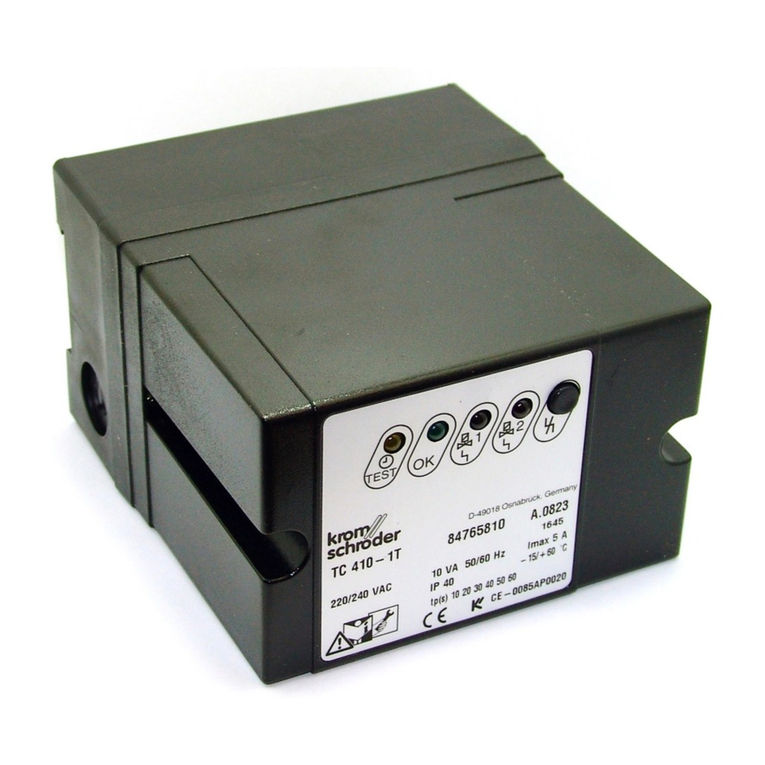
Krom Schroder
Krom Schroder TC 410 User manual
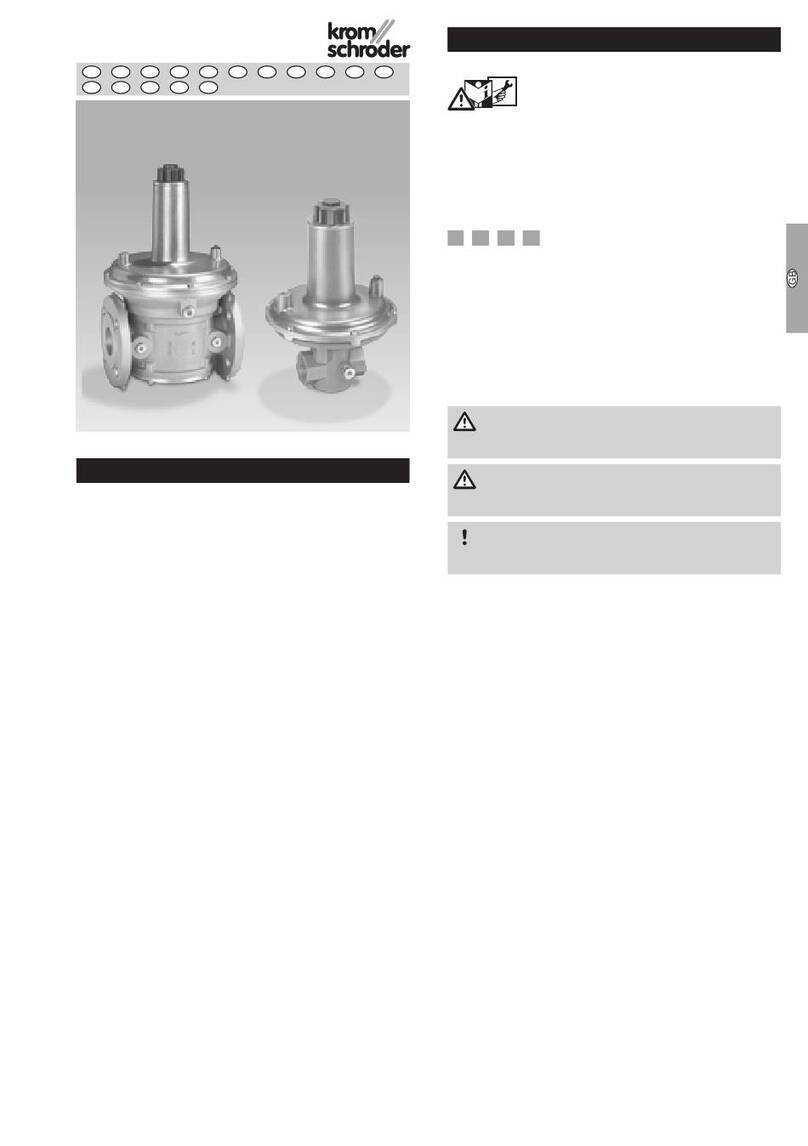
Krom Schroder
Krom Schroder VGBF 15R User manual
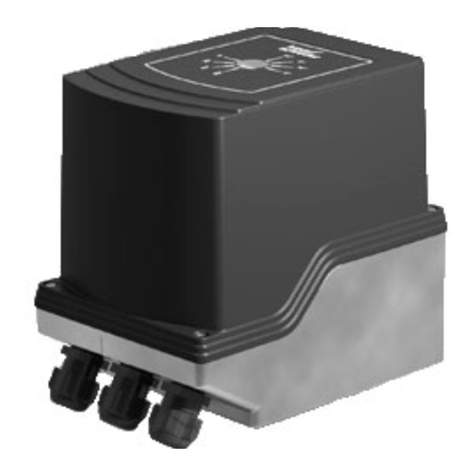
Krom Schroder
Krom Schroder IC 50 Series User manual
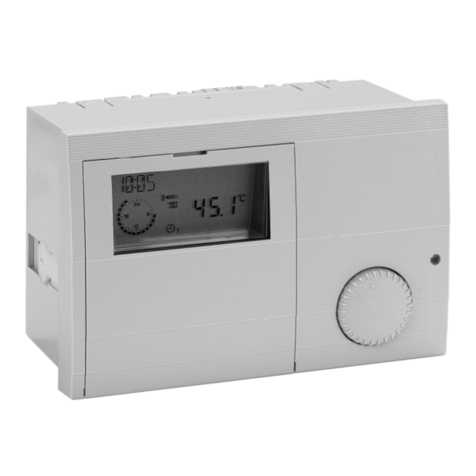
Krom Schroder
Krom Schroder E8.5064 V1 User manual

Krom Schroder
Krom Schroder IC 50 User manual
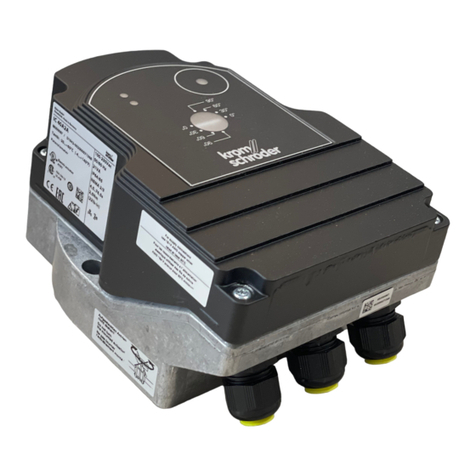
Krom Schroder
Krom Schroder IC 40 User manual

Krom Schroder
Krom Schroder IC 20 User manual

Krom Schroder
Krom Schroder GDJ 15 User manual

Krom Schroder
Krom Schroder VGBF Series User manual
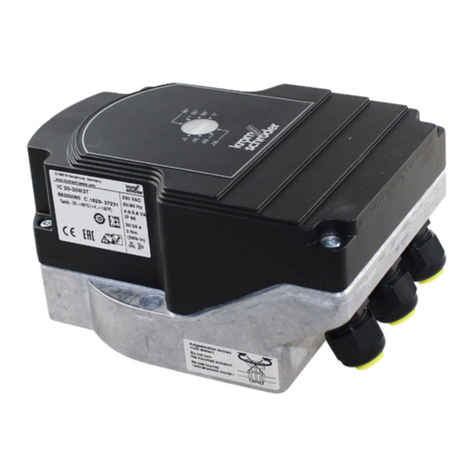
Krom Schroder
Krom Schroder IC 20 User manual
